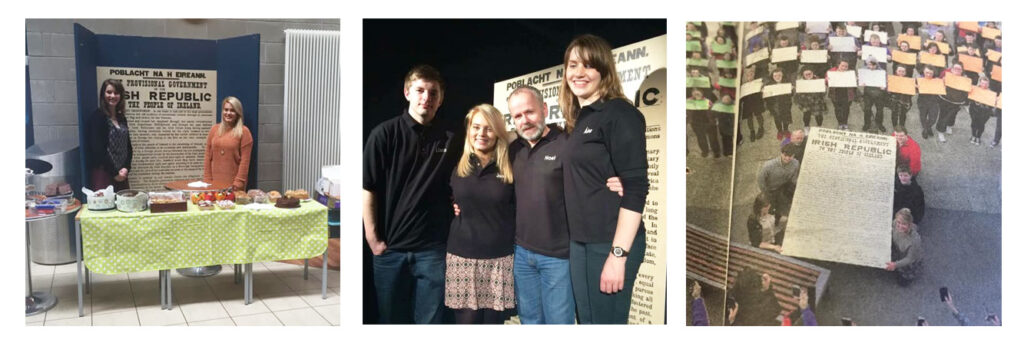‘We declare the right of the people of Ireland to the ownership of Ireland’
Castleisland District Heritage has acquired a replica of Poblacht na hEireann, the 1916 Proclamation of Ireland, measuring an impressive 6ft x 4ft.[1] The artefact was produced in 2016 by a team of third level Multimedia Design students in the (then) Institute of Technology, Tralee.

Noel Nash, one of the team of four who graduated in 2016, works as Illustrator for Castleisland District Heritage and has donated the Proclamation to the archive. Here he explains how the donation came about:
In 2016, I worked with Liam McElligott, Aine Brennan and Jenny Plunkett on an end of year project in Multimedia Design. We worked well as a team, and we all had our separate roles in the degree project. My task was to reproduce each letter of the Proclamation individually and digitally in Adobe Illustrator to create vector images of each. It was painstaking work over a period of many months, and it was ultimately printed with the help of our colleague and friend, Lisa Ronan.
The Proclamation, with other items produced for the project, was placed on display in the college for the 2016 commemorations. The team subsequently approached Kerry County Museum who gladly agreed to display it there for about two or three weeks.

‘They shall be remembered for ever; they shall be speaking for ever; the people shall hear them for ever’ – Pádraic Colum
When the commemoration events were over, the team invited the museum to retain the Proclamation on temporary loan for the benefit of visitors to the museum. From time to time, the former students would routinely call to the museum to admire the results of their labours.
It was on one such occasion on 12 February 2025 that Noel Nash happened to visit:
I was in Tralee waiting for my car to be serviced. I decided to call into the museum and look at the Proclamation to pass a bit of time. The last time I had called in it was on display in the tourist office. As I arrived, I noticed a Kerry County Council van parked outside the museum being loaded with various items such as mannequins. When I went inside the museum I couldn’t see the Proclamation and when I enquired at the reception, I was told that it was being loaded into the van outside for storage!
It was a case of being in the right place at the right time. Noel asked if he could retrieve the Proclamation for the archive of Castleisland District Heritage and it was duly removed from the van and handed over to him.
It is a marvellous acquisition for the archive. It has already been on display in the River Island Hotel for the recent Professor William K Storey event and will be a wonderful focal point for local history and heritage exhibitions.
 John Roche, above left, Chairman of Castleisland District Heritage, helps Noel Nash deliver the Proclamation into the archive in Castleisland. In the centre, Noel Nash pictured with Helen O’Carroll of Kerry County Museum as the Proclamation takes its leave of that venue. On the right, the newly-framed Proclamation – part-financed with the help of Castleisland Chamber Alliance – is returned to Castleisland District Heritage by Sheila and Joanne, daughters of John Roche, after being on display in the River Island Hotel
John Roche, above left, Chairman of Castleisland District Heritage, helps Noel Nash deliver the Proclamation into the archive in Castleisland. In the centre, Noel Nash pictured with Helen O’Carroll of Kerry County Museum as the Proclamation takes its leave of that venue. On the right, the newly-framed Proclamation – part-financed with the help of Castleisland Chamber Alliance – is returned to Castleisland District Heritage by Sheila and Joanne, daughters of John Roche, after being on display in the River Island Hotel
‘Nought have we but some green branches taken from a tree' – James Stephens, 'Spring 1916'
In 1916, the Proclamation was signed by Thomas J Clarke, Sean Mac Diarmada, Thomas Mac Donagh, P H Pearse, Eamonn Ceannt, James Connolly and Joseph Plunkett.
The publication Nation Poems of Ireland’s Great Struggle was also produced in Kerry on the centenary of the Rising and is also held in the archive. It carries portraits of the sixteen men who suffered the ultimate fate, and the nationalist poetry of Co Louth poet, Mary Thomson. It presents the history of Ireland from 1014 to the Rising.[2]

_______________________
[1] Castleisland District Heritage Ref: IE CDH 264. [2] A copy of Nation Poems of Ireland’s Great Struggle Reproduced on the Centenary of the 1916 Rising has been added to this series (IE CDH 264). See also Aftermath of Easter Week (1917) Edited by Pádraig De Brún


